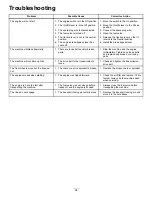
1
2
3
G022085
Figure 13
1.
Dipstick
3.
Lower-limit mark
2.
Upper-limit mark
6.
Read the oil level on the dipstick.
7.
If the oil level is below the lower-limit mark on the
dipstick,
slowly
pour only enough oil into the filler
hole to raise the oil level to the upper-limit mark on
the dipstick.
Note:
Allow the oil to settle before checking the oil
level again.
Important:
Do not overfill the crankcase with oil
and run the engine; engine damage will result.
Drain the excess oil until the oil level reaches the
upper-limit mark on the dipstick.
8.
Insert the dipstick into the filler neck, and rotate the
cap clockwise until it is tight.
Filling the Fuel Tank
Capacity:
0.93 L (0.25 US gallons)
DANGER
In certain conditions, gasoline is extremely
flammable and highly explosive. A fire or explosion
from gasoline can burn you and others and can
damage property.
•
Fill the fuel tank outdoors, in an open area, and
when the engine is cold. Wipe up any gasoline
that spills.
•
Do not fill the fuel tank completely full. Add
gasoline to the fuel tank until the level is 6 to 13
mm (1/4 to 1/2 inch) below the bottom of the
filler neck. This empty space in the tank allows
the gasoline to expand.
•
Never smoke when handling gasoline, and stay
away from an open flame or where a spark may
ignite the gasoline fumes.
•
Store gasoline in an approved fuel container and
keep it out of the reach of children.
•
Do not buy more than a 30-day supply of
gasoline.
DANGER
When fueling, under certain circumstances, a static
charge can develop, igniting the gasoline. A fire or
explosion from gasoline can burn you and others
and damage property.
•
Always place gasoline containers on the ground
and away from your vehicle before filling.
•
Do not fill gasoline containers inside a vehicle or
on a truck or trailer bed, because interior carpets
or plastic truck-bed liners may insulate the
container and slow the loss of any static charge.
•
When practical, remove gasoline-powered
equipment from the truck or trailer and fuel the
equipment with the wheels on the round. If this
is not possible, then fuel such equipment on a
truck or trailer from a portable container, not
from a gasoline-dispenser nozzle.
•
If you must use a gasoline-dispenser nozzle,
keep the nozzle in contact with the rim of the
fuel tank or container opening at all times until
fueling is complete.
Recommended Fuel
•
For best results, use only clean, fresh (less than 30 days
old), unleaded gasoline with an octane rating of 87 or
higher ((R+M)/2 rating method).
11












































